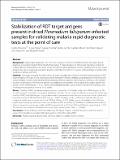| dc.contributor.author | Collins Morang’a, Cyrus Ayieko, George Awinda, Rachel Achilla, Caroline Moseti, Bernhards Ogutu, John Waitumbi, Elizabeth Wanja | |
| dc.date.accessioned | 2022-01-23T11:18:31Z | |
| dc.date.available | 2022-01-23T11:18:31Z | |
| dc.date.issued | 2018 | |
| dc.identifier.uri | https://repository.maseno.ac.ke/handle/123456789/4579 | |
| dc.description.abstract | Background: Malaria rapid diagnostic tests (RDTs) are a great achievement in implementation of parasite based
diagnosis as recommended by World Health Organization. A major drawback of RDTs is lack of positive controls to
validate diferent batches/lots at the point of care. Dried Plasmodium falciparum-infected samples with the RDT target
antigens have been suggested as possible positive control but their utility in resource limited settings is hampered by
rapid loss of activity over time.
Methods: This study evaluated the efectiveness of chemical additives to improve long term storage stability of RDT
target antigens (HRP2, pLDH and aldolase) in dried P. falciparum-infected samples using parasitized whole blood and
culture samples. Samples were treated with ten selected chemical additives mainly sucrose, trehalose, LDH stabilizer
and their combinations. After baseline activity was established, the samples were air dried in bio-safety cabinet and
stored at room temperatures (~ 25 °C). Testing of the stabilized samples using SD Bioline, BinaxNOW, CareStart, and
First Response was done at intervals for 53 weeks.
Results: Stability of HRP2 at ambient temperature was reported at 21–24 weeks while that of PAN antigens (pLDH
and aldolase) was 2–18 weeks of storage at all parasite densities. The ten chemical additives increased the percentage
stability of HRP2 and PAN antigens. Sucrose alone and its combinations with Alsever’s solution or biostab signifcantly
increased stability of HRP2 by 56% at 2000 p/µL (p < 0.001). Trehalose and its combinations with biostab, sucrose
or glycerol signifcantly increased stability of HRP2 by 57% (p < 0.001). Unlike sucrose, the stability of the HRP2 was
signifcantly retained by trehalose at lower concentrations (500, and 200 p/µL). Trehalose in combination biostab stabilizer increased the percentage stability of PAN antigens by 42, and 32% at 2000 and 500 p/µL respectively (p < 0.01).
This was also the chemical combination with the shortest reconstitution time (~ < 20 min).
Conclusions: These fndings confrm that stabilizing RDT target antigens in dried P. falciparum-infected samples
using chemical additives provides feld-stable positive controls for malaria RDTs. | en_US |
| dc.publisher | BioMed Central | en_US |
| dc.subject | Malaria, Rapid diagnostic tests, Chemical additives, Stability, Positive controls | en_US |
| dc.title | Stabilization of RDT target antigens present in dried Plasmodium falciparum-infected samples for validating malaria rapid diagnostic tests at the point of care | en_US |
| dc.type | Article | en_US |

